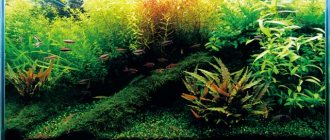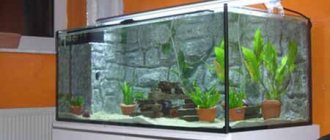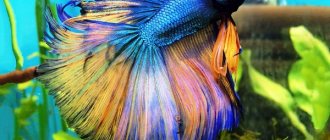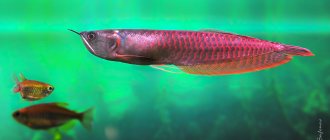Starting an aquarium on the ground ADA Aqua Soil Amazonia
I've been working toward this launch for about two years. I had a 100 liter planted aquarium with Dennerle crystal quartz substrate. Everything in it grew quite well, even though it was “empty”. That is, it was pure quartz without any nutrient support. But the size of the aquarium was not very suitable for creating an underwater composition, and I decided to change the aquarium to a larger one. I chose an aquarium from Nature Aqua. You can read about it here. Naturally, the question arose about choosing soil for a new aquarium. Since I planned to disassemble the old aquarium. The most obvious option was to purchase Dennerle crystal quartz and DeponitMix Professional nutrient substrate, and start the aquarium on Dennerle substrate. But I didn't really like the red color of my crystal quartz. And if I still had to buy the entire primer for launch, then I started looking at other primers.
I was familiar with the widely advertised ADA primer from the forums. The reviews were positive, if not enthusiastic. The most popular was ADA Aqua Soil Amazonia. This is the most nutritious soil from the entire ADA line. Essentially, it is granular black soil that contains all the necessary organic acids and nutrients for healthy plant growth in a natural aquarium. The color of the primer is dark brown - just what I wanted. Also, ADA Aqua Soil Amazonia reduces the carbonate hardness of water (KH) and lowers the pH, making the water acidic, thereby creating more favorable conditions for plant growth. The water from my tap had a high KH, and since I initially planned to pour water from the tap rather than run it through osmosis, this became decisive in the choice of soil.
|
|
ADA Aqua Soil Amazonia comes in two fractions. Normal - 2-4 mm. Small - 1-3 mm. The fine fraction is great for small nano aquariums. Fine fraction soil has the prefix Powder in its name. The granules are fired in a kiln and are quite strong; they do not crumble when squeezed with your fingers. When starting aquariums on ADA soil, some people don’t bother; they pour Aqua Soil Amazonia into the aquarium without any substrate and generally don’t complain. I decided to go all the way (well, almost) and run the aquarium as expected.
An important component in the ADA soil system is the substrate under the soil - Power Sand. It is a porous material similar to lava. Contains all the necessary nutrients for the growth of aquarium plants. Bacter 100 bacteria have been added to the substrate. They help to quickly start up the aquarium. It also contains Clear Super, which makes the water crystal clear and prevents the appearance of white bacterial turbidity. Thanks to Power Sand, water, and with it oxygen, circulate freely in the lower layer of soil, providing favorable conditions for the life of nitrifying bacteria and the roots of aquarium plants, preventing acidification and caking of the Aqua Soil Amazonia base soil. Available in three fractions S, M and L. The size of the required fraction depends on the size and volume of the aquarium. I would divide them approximately like this: up to 50 liters - S; from 50 to 200 - M, over 200 - L.
ADA Power Sand Factions
It just so happened that I had faction M and had to run on it. Despite the presence of Bacter 100 and Clear Super in the soil, I bought them separately, as well as Penac P, Penac W and Tourmaline BC. I will not go into a complex description of the last three drugs, but the instructions promise that they in every possible way promote the growth and rooting of plants. Let's hope that's the case. It seems to me that it’s quite possible to do without them, but I was lucky and a friend of mine at the market sold these powders in measuring spoons, which was several times cheaper than jars, so I decided to take the full set.
The stocked aquarium is ready to start.
First of all, I pour Tourmaline BC and Clear Super with a spoon evenly over the entire bottom area. Then Power Sand in a layer of 1.5-2 centimeters.
On top of Power Sand I add Penac P, Penac W, Bacter 100 and Aqua Soil Amazonia base primer. I poured it with a slope from the back wall to the front. This gives the aquarium a three-dimensional look. As a result, the slope was not very large; it was quite possible to do more. Next is fitting and installation of driftwood. When installing driftwood, it is important to ensure that it sinks. Otherwise, when water is poured, they will float up and all efforts to place the snags will be in vain.
Now you can place a saucer on the ground and carefully pour settled water onto it so that it covers the ground, and begin planting the plants. This is best done with long tweezers. IMPORTANT! There should be a lot of plants when starting on ADA soil! Since there are a lot of nutrients in the soil and when started they will get into the water in large quantities, it is necessary that they are actively absorbed by the plants, otherwise algae will grow. You can temporarily plant fast-growing plants.
Among the plants, I planted Thai fern, rotala indica (great for starting because of its fast growth), blixa japonica, anubias of various types, hemianthus cube and montecarlo. I planted the latter on opposite sides. I wanted to see what would grow better and what I liked the most, then leave it (in the end I left Montecarlo). I can say with confidence that it was necessary to plant 2-3 times more plants. With my bright light, nutritious soil and low plant biomass, I quickly had an algae outbreak. Also, when starting on ADA soil, it is necessary to make daily (!) changes for a week, 25 percent of the total volume, to remove excess nutrients from the water.
Video of launching an aquarium on the ground from ADA.
In conclusion, I would like to write my impression of using ADA Aqua Soil Amazonia. I definitely liked the soil. Plants grow and take root on it perfectly. It holds its shape perfectly. With it you can create the desired underwater landscape. Really lowers KH and pH. Plants grow great with it even in my hard tap water. But you need to start an aquarium on it according to all the rules, with frequent water changes, otherwise problems with algae cannot be avoided.
ada aqua soil
Oliver Knott reviews of Aqua Soil on APC: · gives crystal clear water; · the big advantage is that the substrate has a high density, so it is very good to plant plants; they do not float up in the next days after planting, especially long-stemmed and “lawn” ones; · does not require washing, therefore it is well suited for building a composition “dry”; · after three years in the aquarium, 90% of Aqua Soil remains in the same solid form; · to reuse it, you need to carefully rinse it with cold water and dry it before putting it back into the aquarium, place 0.5-1 cm of fresh Aqua Soil on top so that small particles of the old one do not spread out.
• Oliver Knott at APC says that you should never rinse Aqua Soil with hot water before reusing it - it will ruin it!
Aqau Soil can be used many times by first cleaning it with a siphon from the decomposed part - “dirt”, and then drying it to a slightly damp state (if it is overdried, it disintegrates!). To change the composition, it is not at all necessary to take out the Aqua Soil - just siphon it and add fresh one on top. Rumors that Aqua Soil needs to be changed after a year of the aquarium’s life are completely untrue. Takashi Amano has aquariums that are more than three years old. Moreover, the last few issues of Aqua Journal have been devoted to the topic of creating long-term aquariums using Aqua Soil. Aqua Soil holds the ground slope much better than any gravel. Of course, the supply of food in Aqua Soil is gradually depleted, but there are ADA sticks for this. and the application of liquid fertilizers with macro-elements starting from 6-12 months from the moment of setting up the aquarium.
| Dosage of ADA Power Sand and Aqua Soil. | ||
| Aquarium size | Power Sand quantity | Aqua Soil quantity |
| 60x30x36h | 2L size “S”, Regular or Special type | 1 package 9l + 1 package 3l |
| 90 x 45 x 45h | 4-6l 2-3 bags of 2l, size “M”, Regular type, and up to 1 bag of 6l Special | 3-4 bags 9l |
| 120 x 45 x 45h | 6l 3 bags 2l “M”, Regular type | 4 bags of 9l (+ 1-2 bags of 3l if slope is needed) |
| or 1 package 6l “M”, type Special | ||
| 180 x 60 x 60h | 12-18l 6 bags 2l "L" type Regular | 7-9 bags 9l |
| or 1 package 18l “L” type Special | ||
| Source: online store for ADA USA products - ADGshop, USA. (Jeff Senske) | ||
There are many examples where people simply dried Aqua Soil in the sun or in an oven at 100 degrees in the oven, and reused it without any problems. Considering Jeff Senske's opinion on Amazonia II, it is better to use regular Amazonia (not -II).
Starting an aquarium using ADA Aqua Soil.
Aqua Soil was never intended to be used without Power Sand, which T.Amano always uses as a base layer, although many aquascapers do without it. Aqua Soil contains a small amount of NH4+/NO3, but Power Sand contains a lot of organic matter. Tourmaline BC trace elements are added separately. According to Tom Barr tests, the NO3 in Power Sand is 50 times greater than in Aqua Soil. Aqua Soil also contains a lot of Fe, especially the "Amazonia" version.
Such a large amount of ammonium in Power Sand and the strong water buffering effect of Aqua Soil require certain rules to be followed when starting an aquarium with an ADA substrate.
First, the filter must be cycled (to quickly oxidize the excess NH4+ released to NO3, which is much less algae-causing).
In the first weeks, the water may become very cloudy. This happens for two reasons: the release of humic acids, or bacterial turbidity. Strong buffering can lower the pH in the first days to a critical level and cause severe turbidity in the water. The ADA has clear recommendations on this matter:
“Since AQUA SOIL significantly lowers pH, GH and KH, it is important to use tap water (not RO!) when setting up the aquarium and the aforementioned water changes (about 30-50% weekly). The hardness of tap water varies. Recommended values are 3-4KH and 6-8GH. For example. We recommend using 50% tap water, with KH 8-10 and GH 15-20, with 50% reverse osmosis water. After about ten water changes, maintain a 4:1 .” (ADA) Another option: “...first prepare the substrate by immersing Aqua Soil in [tap] water without plants or fish for a while, changing the water frequently until you reach a neutral pH. Then the substrate can be transferred to the aquarium and plants can be planted.” (adana-usa.com, Aquarium Bed FAQ's, PDF 4.9Mb)
In this diagram you can see the buffering properties of Aqua Soil Amazonia and Africana. Calcium hydroxide was added to 20 ml of clean water and the pH was measured. As you can see, it can lower the pH to 2.3. After stabilization, the pH is set at ~6.5 (blue line - regular ADA Bright Sand). US ADA dealer Jeff Senske says the drop in pH is nothing to worry about. After a while everything will stabilize. This does not cause any harm to fish and shrimp. It doesn't even test the pH - just a visual observation of the condition of the plants. There is no need to add liquid macroelements other than potassium with the ADA substrate (one Aqua Soil or together with Power Sand) for the first few months - there is enough nutrition in the soil. If algae appears, simply reduce the nitrogen:phosphorus dose a little and increase water changes until everything returns to normal. He advises not to use tests but to be guided solely by monitoring the condition of the plants. As for yellow water, activated carbon helps very well for the first 2-4 months. Jeff emphasizes that he has never used Aqua Soil WITHOUT Power Sand - it was created only to be used in conjunction with it. The ADA company's instructions for starting an aquarium with Aqua Soil Amazonia Maintenance of Aqua Soil-Amazonia at initial stage after Setup says that of the three types of Aqua Soil, the Amazonia version gives the best plant growth due to the large amount of organic matter and humic acids - it is the latter that initially turns the water yellow. . All you need to do is change the water more often. If the yellow color does not go away or is too intense, add activated carbon to the filter and add ADA Green Bacter. But there is also the opposite warning. When pouring very hard water (pH>7.5), a particularly large release of humates occurs, which tend to lower kH/pH. The cloudiness of the water will be yellow-brown, and the granules will become much easier to disintegrate. In this case, it is better to fill with softened water by mixing tap water with RO water.
In the first days after setting up an aquarium with ADA Aqua Soil, a whitish bacterial turbidity may appear. To eliminate such turbidity in the water, adding ADA Green Bacter and maintaining a good state of biofiltration plays an important role: “Optimal filter condition. The condition of the filter can be determined by the condensation (clumps of bacteria) of organic sediment formed by the activity of bacteria and protozoa. If the congulation is viscous and solid aerobic life is more energetically efficient. Conversely, if particle congruence is poor and particles are scattered, biological activity is reduced. If this happens and no action is taken, it can lead to a decrease in water quality - particles will float randomly making the water cloudy. Although some aquarists may rely on using a UV lamp to purify their water, this will not have a long-term effect as the UV lamp will also kill the beneficial bacteria in the filter resulting in zero biofiltration. ADA Clarification on Water Cloudiness: “The clarity of the water in your aquarium. Organic sediment, which often makes up the majority of suspended solids and dissolved solids in water, is broken down by bacteria. Decomposition products will include ammonium NH4 and dissolved organic matter. If the filter is working well, a large number of bacteria will quickly form in it. These bacteria usually return back to the aquarium. This often leads beginners to the conclusion that “the water is always cloudy.” Turbid water arising for this reason should not worry you, since the organic sediment will be decomposed and consumed by protozoa like Amoebae and Zolium.” (from: A primer on high-capacity filtration, Aqua Journal #34 Eng.)
If you do not use ADA fertilizers, apply other micro fertilizers for the first month or two, starting with half the dosage. Of course, nitrogen and phosphorus (homemade or ADA - Green Brighty Special LIGHTS and SHADE) are not added at all during the first months - the substrate (even homemade) has enough nutrition. You cannot put Aqua Soil in the bottom layer and sprinkle 2...5mm gravel on top - this not only crushes the Aqua Soil granules, but also blocks the movement of water and permeability for roots!
When setting up an aquarium, when it is first filled with water, Aqua Soil will make the water very cloudy. Fill the aquarium to half the volume, and if the water is too cloudy, immediately change it to a new one. You need to be careful with the filter - particles of this substrate can quickly clog the filter material, bacteria will not receive enough oxygen, and the efficiency of biofiltration will greatly decrease. This can very quickly lead to the accumulation of NH4+ and the appearance of algae, especially water blooms. The first signal of deteriorating biofiltration is the appearance of a bacterial film on the surface of the water. During this period (the first two to three weeks), you need to wash the filter 1-2 times a week and turn on aeration at night to give the bacteria oxygen (there is still little of it in the water since the plants are not yet growing intensively). (ADA)
It is also important to know that Aqua Soil is a rather soft substrate and cannot be used for VERY large aquariums with a depth of 1m or more - high water pressure destroys the granules and the water will always be cloudy. Tom Barr once had the sad experience (I hate ADA aqua soil – April 16, 2007) of seven months of muddy water that was not purified by any means or filters. It will also not be possible to set up such an aquarium - you cannot walk on Aqua Soil. In such aquariums it is better to use gravel or hard substrates with a high CEC Profile/Turface, Eco-Complete, zeolite, diatomite and add vermicompost + FTE.
Aqua Soil Amazonia II
In 2007, a new variety of Aqua Soil was released - Aqua Soil-Amazonia II (packaging): “Aqua Soil Amazonia has been used by many planted aquarium hobbyists around the world as the main substrate for growing aquatic plants. Aqua Soil Amazonia is made from black soil rich in organic matter that promotes plant growth, and most species of aquatic plants can grow healthy in Amazonia. But, in hard water there have been rare reports that organic substances such as humic acids can be released into the water and cause coloration and cloudiness in the water. This time, Aqua Design Amano presented Aqua Soil Amazonia II - a new type of Aqua Soil substrate that is made from a mixture of soils of different proportions, preventing coloration and cloudiness of the water. Since the color and growth of the plants is slightly different from the existing product line, we will continue to sell Aqua Soil Amazonia. Choose according to your needs and preferences. But, if you have hard water, we recommend using Amazonia II." (ADA)
But, after his very positive reviews of Amazonia II (11-27-2007), Jeff Senske later changed his opinion to the opposite: “After gaining some extensive experience and receiving many reviews from consumers, I can officially declare that the regular Amazonia is superior to Amazonia II. Personally, I will not use Amazonia II in any ADG or my own aquariums in the future. With regular Amazonia the growth is better, it is harder, therefore will last longer and allow more re-scaping, and the consistency of the classic color is also a plus. We give the best reviews about the usual Amazonia, and the problems that arise at the start are easily overcome. Regardless of the hardness of your tap water, for best plant growth and long-lasting substrate performance, use regular Amazonia.” (A word about Amazonia vs. Amazonia II, Jeff Senske 05-11-2008) “Personally, I will never use Amazonia II again. 100% just regular Amazonia, period.” “I was considering using the Amazonia II until I encountered its poor performance (compared to the regular Amazonia) over long periods of use, plus the cloudy water problems reported by many users. So now I only recommend regular Amazonia for all applications without the need to use RO water or any other special methods. I always use ADA NA Carbon AND ADA Bamboo Charcoal in new aquariums, and have found that using ADA Green Bacter exactly as directed in the first week SIGNIFICANTLY reduces the initial cloudiness of the water. My 120 gallon homemade Iwagumi (with a sparse planting of "broadleaf" E.tennelus) is completely clean after 10 days. To be honest, I did not use ADA Green Bacter regularly and underestimated its effectiveness in reducing the initial cloudiness of water when using Amazonia. Bottom line - for best results, always use regular Amazonia. It's a 'live and learn' situation, like everything in life." (Jeff Senske)
For more information about the properties of this or that type of Aqua Soil and the features of starting an aquarium with such a substrate, see the article How to use Aqua Soil. There are many tips and recommendations for using such substrates in the article about ten alternatives to ADA Aqua Soil.
Ivanyushin Ruslan (aka naman), ©2004-2008.
* the author of the article says that the soil with a bottom layer of Power Sand and a top layer of Aqua Soil is very rich, but organic matter is added only for the first year of the aquarium’s life (see PMAS). Indeed, such soil is extremely good for starting plant growth due to its organic content and high CEC and is able to accumulate microelements and nutrients directly from water after applying liquid fertilizers and/or from sludge. For more details, see the Substrate section. ** it is now known that Aqua Soil is a mixture of clay with tropical soil rich in organic matter
ADA Aqua Soil analysis by Tobias Coring - analysis of the composition of a series of substrates ADA Aqua Soil BarrReportAnalysisofSediments.pdf 442.1 KB - comparative test of Aqua Soil Amazonia and other substrates Il fondo nella vasca dedicata alle piante di Fabrizio Lattuca - data on CEC Aqua Soil Amazonia The Magical Substrate Called Aqua Soil by Ryan Stover is the first article in English about Aqua Soil by an American aquarist who lived in Japan for several years. Aqua Journal Vol.38 - A Symposium on Characteristics of ADA Aqua Soil Aqua Journal Vol 36 - The Ideal Substrate (detailed article, analysis of substrate combinations and their types) ADA Manual 2002/2003 from https:/ /www.aqua-shopping.net/cnt/howto/index.htm (use the Japanese to English translator in the Maxthon (MyIE) browser - Tools>Translation&Service>Babel Fish: Japanese to English) Innovative Earth, adana-usa.com - reducing water hardness and pH Aqua Soil Amazonia and Africana ADA instructions for Aqua Soil: Maintenance of Aqua Soil-Amazonia at initial stage after Setup Does EI + ADA's aqua soil work well? Journal of starting an aquarium with Aqua Soil (without Power Sand) with JBL Denitrol without plants and lighting - tracking the dynamics of NH4+ Journal of an aquarium Aqua Soil+Power Sand+Tourmaline BC+Bactor 100- Neil's 60 ADA Nature Aquarium Journal Experience using Aqua Soil - For those of you thinking about changing to ADA Aquasoil e Nile Sand - aquatic.net, luis moniz - photo of packaging Aqua Soil and Nile Sand Powder vs Regular - Creative Aquascaping Union: see The Two Tower setup (60cm) by Alan Chan. ADA soils, Power sand and Water column fertilizing, Thom Barr, 2005 ADA product analysis test, Tom Barr, 05-08-2007 Tom Barr promised to test the main ADA products! I hate ADA aqua soil – 16 April 2007 Tom Barr Aqua Soil Amazonia II An analysis of Sediments, Growth and Water Column Nutrient Concentration Breakdown ADA Product Line and other sediments, Part 1; Tom Barr (BarrReportAnalysisofSediments.pdf 442.1 KB) Relationship between Fumic Acid and the Force of Ion Exchange Adsorption of River Sediment.; Koizumi Sadayuki, Takayama Katsumi, 1999 How to use Aqua Soil - Aqua Journal On-line Aqua Soil - Amazonia Initial Stage Maintenance











